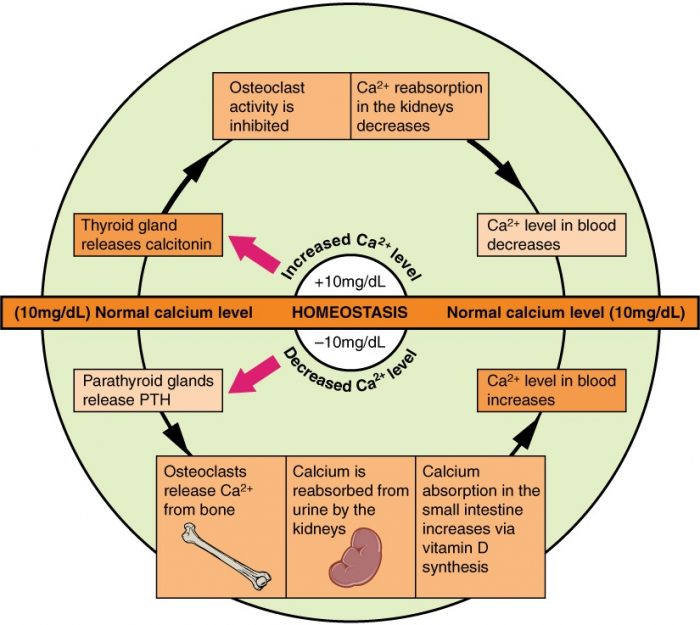
Homeostasis is the tendency for the cells in a body, and therefore the body at large, to maintain a stable and consistent internal environment. Maintaining homeostasis is necessary for cells to be able to carry out their functions, exist, and replicate.
The body has various methods of maintaining homeostasis, with many systems working together to achieve it. Some examples of the systems/purposes which work to maintain homeostasis include: the regulation of temperature, maintaining healthy blood pressure, maintaining calcium levels, regulating water levels, defending against viruses and bacteria.
A Detailed Look At Homeostasis
Before delving into specific examples of homeostasis, let’s take a moment to define homeostasis and better understand what it is. Homeostasis is, in short, the actions the body undergoes to maintain a stable state and resist change. Homeostasis makes use of negative feedback loops which work to counteract environmental forces that will change the properties of cells.
Biological systems, such as your liver, your heart, your muscles, and your body as a whole, are constantly being impacted by outside forces that will shift the cells comprising them away from points of balance. When you use your muscles, for example, they release heat energy and the temperature of your body goes up. Maintaining homeostasis is dependant upon your body’s ability to counteract these changes. Negative feedback loops are employed by the body to maintain homeostasis. A negative feedback loop counteracts the forces of change that act on the body, opposing the stimulus that prompts those changes. When your body is heating up, a negative feedback loop kicks off and as long as the temperature is above the stable target value of approximately 37.0 degrees Celsius (or 98.6 degrees Fahrenheit), the negative feedback loop will continue and your body’s temperature will trend downwards.
The negative feedback loop works by responding to a stimulus. In the example of high body temperature, the temperature exceeding a certain level is the stimulus and this temperature is detected by nerve cells. These nerve cells send the information to a portion of the brain responsible for temperature regulation. The control center in the brain interprets this information and responds by sending signals to effectors, systems like sweat glands, which are intended to oppose the stimuli and bring the temperature of the body back down to normal levels.
Negative feedback loops are involved in homeostasis, but so are positive feedback loops. While most homeostatic systems involve negative feedback loops, some systems utilize positive feedback loops instead. Consider the fact that while your body can exceed a certain temperature, it can also drop below a desired temperature. When you are too cold, your body responds in multiple ways to keep you warm, one of which includes shivering (which releases heat energy). This means that homeostatic systems may be comprised of two different parts, a negative feedback loop, and a positive feedback loop.
The negative feedback loop functions to counteract a stimulus by reducing something when it is above a set point while the positive feedback loop functions by increasing the level of something until it is at the desired point. The fundamental distinction between negative feedback loops and positive feedbacks loops is that positive feedback loops amplify some signal that they are given. For this reason, positive feedback loops are often used to complete a process, as opposed to maintaining the status quo.
Comparing And Contrasting Positive And Negative Feedback Loops In Action
Let’s examine how positive and negative feedback loops respond to stimulus to make the distinction between the two different loops clearer.
As mentioned, your body has sensors in it that detect if the body drops below a certain point or increases above a certain point. The temperature regulation portion of the brain is found in the hypothalamus. Your hypothalamus will respond to drastic changes in your body’s temperature. If it is a particularly hot day or if you have been exercising particularly hard, your body responds by kicking off various mechanisms intended to decrease its temperature. For one, the body begins producing sweat which helps reduce heat as the sweat evaporates. Heavy breathing can also increase the rate at which heat is lost. Blood vessels also move towards the surface of the skin, which facilitates the diffusion of heat to the environment.
By contrast, if one is too cold, the hypothalamus kicks off a different set of reactions. If it is a windy day and you are dressed too lightly, your brain responds by activating numerous processes intended to keep you warm. The blood flow to the skin decreases so that you can maintain heat better, and your body gets goosebumps which help trap a layer of warm air near the skin. Shivering also helps generate body heat.
It should be noted that the temperature threshold which can kick off a positive feedback loop or a negative feedback loop can shift, it isn’t a constant value. Your body temperature can change over the course of the day, being lower during the early morning and being higher in the late afternoon. Certain changes in body chemistry, such as a response to a fever can also change the threshold at which heat reduction feedback loops are started.

How body temperature changes over the course of the day. Photo: By Unknown – Image Source, Public Domain, https://commons.wikimedia.org/w/index.php?curid=227449
While the reactions that occur when you are too cold is one example of a positive feedback loop, another example of a positive feedback loop involves the process of childbirth. Remember that positive feedback loops are often used to push a process to completion, and this is the case here. The positive feedback loop facilitates the birth of the baby, and neurons in the brain receive a signal that prompts it to release oxytocin. The brain receives the signal when the babies head presses on the cervix, which is the bottom portion of the uterus. The effect of oxytocin is to increase the contractions of the uterus, and the result is even more pressure on the cervix, which prompts the release of more oxytocin, and onwards. This positive feedback loop will continue until the process is completed and the baby has been born.
Disruptions To Feedback Loops And Homeostasis
Maintaining homeostasis is dependent on the functioning of negative feedback loops, meaning that if these loops are interrupted, homeostasis is typically interrupted as well. The interference of feedback mechanisms often causes diseases such as diabetes, which results from the breakdown of the feedback loop responsible for the production of insulin. Because the hormone insulin is not produced in sufficient numbers, it is difficult for the body to control its blood sugar level. Normally, blood sugar levels are controlled by insulin and glucagon.
Insulin is what brings the concentration of glucose within the blood down, and glucose levels themselves rise after you consume a meal. As blood glucose levels rise, insulin secretion is kicked off by the beta cells within the pancreas, and this insulin goes on to trigger the response of other cells within the body such as muscle cells and fat cells. These other cells absorb the glucose and use it as fuel. Insulin has another effect in the body, it causes glucose to be transformed into the storage molecule glycogen, located in the liver. Acting together, these processes pull sugar from the blood and blood sugar to regular levels, and as the levels of blood sugar decrease insulin secretion also stops and returns to normal levels.
While insulin decreases the concentration of glucose in the blood, glucagon has an opposite effect, increasing the concentration. Your blood glucose levels fall if you haven’t eaten anything for a long while, and if this happens elsewhere cells within the pancreas release glucagon. This glucagon reacts with the liver, and glycogen found there is degraded into glucose and released into the bloodstream of the body, which has the effect of raising blood sugar levels.
Five Examples Of Homeostasis
Body Temperature: The process that regulates body temperature has been covered above.
Blood Pressure: The system that maintains healthy blood pressure is an example of homeostasis. The maintenance of healthy blood pressure is one example of a homeostatic process, with the body responding to changes in blood pressure by sending signals to the brain. The brain interprets the signals and sends instructions to the heart to either speed up if blood pressure is too low or slow down if blood pressure is too high.

Example of the system that maintains calcium levels. Photo: By Anatomy & Physiology, Connexions Web site. https://openstax.org/books/anatomy-and-physiology/pages/1-introduction, Jun 19, 2013. – OpenStax College, CC BY 3.0, https://commons.wikimedia.org/w/index.php?curid=30017603
Calcium Levels: Calcium levels in the body have to be within a range of acceptable parameters, and the body regulates this process through the release of hormones in another example of homeostasis. Thyroid hormones are responsible for regulating calcium levels, fixing calcium within the bones if the calcium levels become too high, which results in the lowering of calcium levels within the blood.
Water Levels In The Body: Yet another example of homeostasis is the regulation of water levels in the body. Although more than half of the body’s weight is water weight, the cells of the body must have a balance of water within them. Cells that have too much water can bloat and even rupture while cells with too little water will shrink. When you are thirsty and intake water, this water is distributed to the cells that need it.
Defending Against Infection: As a final example of homeostasis, consider how your body responds to different viruses or bacteria that get into it. Your lymphatic system is responsible for neutralizing these threats, working to resolve the issue and fight off the infection before it can take root within your body.










